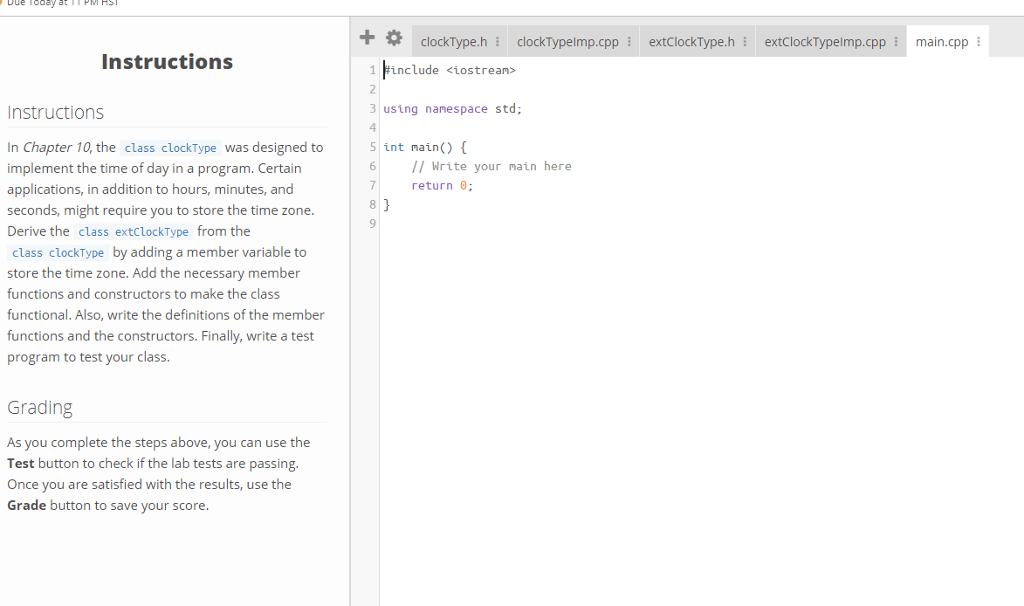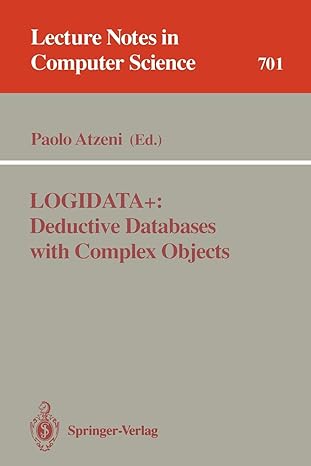Question
Must be in C++ and use classes that are tabbed. Below will be the code I have for each one except for main.cpp because it
Must be in C++ and use classes that are tabbed. Below will be the code I have for each one except for main.cpp because it is the picture.
clockTypeImp.pp
//Implementation File for the class clockType #include if (0 if (0 void clockType::getTime(int& hours, int& minutes, int& seconds) const { hours = hr; minutes = min; seconds = sec; } void clockType::incrementHours() { hr++; if (hr > 23) hr = 0; } void clockType::incrementMinutes() { min++; if (min > 59) { min = 0; incrementHours(); } } void clockType::incrementSeconds() { sec++; if (sec > 59) { sec = 0; incrementMinutes(); } } void clockType::printTime() const { if (hr if (min if (sec bool clockType::equalTime(const clockType& otherClock) const { return (hr == otherClock.hr && min == otherClock.min && sec == otherClock.sec); } clockType::clockType(int hours, int minutes, int seconds) { if (0 if (0 if (0 clockType::clockType() //default constructor { hr = 0; min = 0; sec = 0; } -------------------------------------------------------------------------- clockType.h //clockType.h, the specification file for the class clockType #ifndef H_ClockType #define H_ClockType class clockType { public: void setTime(int hours, int minutes, int seconds); //Function to set the time. //The time is set according to the parameters. //Postcondition: hr = hours; min = minutes; // sec = seconds // The function checks whether the values of // hours, minutes, and seconds are valid. If a // value is invalid, the default value 0 is // assigned. void getTime(int& hours, int& minutes, int& seconds) const; //Function to return the time. //Postcondition: hours = hr; minutes = min; // seconds = sec void printTime() const; //Function to print the time. //Postcondition: The time is printed in the form // hh:mm:ss. void incrementSeconds(); //Function to increment the time by one second. //Postcondition: The time is incremented by one // second. // If the before-increment time is 23:59:59, the // time is reset to 00:00:00. void incrementMinutes(); //Function to increment the time by one minute. //Postcondition: The time is incremented by one // minute. // If the before-increment time is 23:59:53, // the time is reset to 00:00:53. void incrementHours(); //Function to increment the time by one hour. //Postcondition: The time is incremented by one // hour. // If the before-increment time is 23:45:53, the // time is reset to 00:45:53. bool equalTime(const clockType& otherClock) const; //Function to compare the two times. //Postcondition: Returns true if this time is // equal to otherClock; otherwise, // returns false. clockType(int hours, int minutes, int seconds); //constructor with parameters //The time is set according to the parameters. //Postcondition: hr = hours; min = minutes; // sec = seconds // The constructor checks whether the values of // hours, minutes, and seconds are valid. If a // value is invalid, the default value 0 is // assigned. clockType(); //default constructor with parameters //The time is set to 00:00:00. //Postcondition: hr = 0; min = 0; sec = 0 private: int hr; //variable to store the hours int min; //variable to store the minutes int sec; //variable to store the seconds }; #endif ----------------------------------------------------------------------- All other classes have no code as of now. 
Step by Step Solution
There are 3 Steps involved in it
Step: 1

Get Instant Access to Expert-Tailored Solutions
See step-by-step solutions with expert insights and AI powered tools for academic success
Step: 2

Step: 3

Ace Your Homework with AI
Get the answers you need in no time with our AI-driven, step-by-step assistance
Get Started


